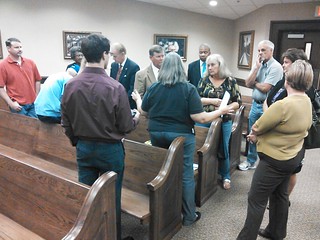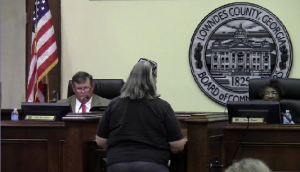
ABC News Blogs 14 November 2013, Florida Sinkhole Swallows Home
Six other homes have been evacuated as a precaution and Duke Energy has shut down power to the area.
A growing sinkhole in Florida has swallowed Continue reading

ABC News Blogs 14 November 2013, Florida Sinkhole Swallows Home
Six other homes have been evacuated as a precaution and Duke Energy has shut down power to the area.
A growing sinkhole in Florida has swallowed Continue reading
 A local mom said she was one of many landowners being bullied
by a pipeline company and asked for help from local leaders,
at the
7 November 2013 Valdosta City Council Regular Session.
A local mom said she was one of many landowners being bullied
by a pipeline company and asked for help from local leaders,
at the
7 November 2013 Valdosta City Council Regular Session.
Here’s Part 1 of 2:
 Carol Singletary’s impassioned and reasoned plea
got a response from Mayor John Gayle,
even if it was only Continue reading
Carol Singletary’s impassioned and reasoned plea
got a response from Mayor John Gayle,
even if it was only Continue reading
Commissioners at least listened about the proposed Sabal Trail Transmission pipeline, at the Lowndes County Commission Regular Session 2013-10-22. Now what will they do?
 Video.
The Chairman started out reiterating his disclaimer of county responsibility from back in June,
but
at least this time said they’d take a look at it and they understood
what people were going through.
Carol Singletary started to respond, and Slaughter said they would
talk to her in a few minutes.
And they did.
Video.
The Chairman started out reiterating his disclaimer of county responsibility from back in June,
but
at least this time said they’d take a look at it and they understood
what people were going through.
Carol Singletary started to respond, and Slaughter said they would
talk to her in a few minutes.
And they did.
Here’s Part 1 of 2:
Commissioners listened about the pipeline Part 1 of 2:
Regular Session, Lowndes County Commission (LCC),
Video by Gretchen Quarterman for Lowndes Area Knowledge Exchange (LAKE),
Valdosta, Lowndes County, Georgia, 22 October 2013.
 Video of after adjournment. See
previous post about how unusual Continue reading
Video of after adjournment. See
previous post about how unusual Continue reading
A citizen didn’t appreciate a pipeline company’s bullying, especially when a second pipeline would make his land mostly useless and hard to sell, at the Lowndes County Commission Regular Session 2013-10-22.
 Video.
He said he had an existing pipeline less than fifty feet from his back yard,
and this one would be less than sixty feet on the other side,
wiping out the use of much of his property,
including planting trees.
He said he probably couldn’t even sell his property with two pipelines on it.
He asked for help from the Commission.
Video.
He said he had an existing pipeline less than fifty feet from his back yard,
and this one would be less than sixty feet on the other side,
wiping out the use of much of his property,
including planting trees.
He said he probably couldn’t even sell his property with two pipelines on it.
He asked for help from the Commission.
Commissioner Crawford Powell asked for the name of the road Kicklighter lived on.
Here’s the video: Continue reading
A citizen brought up the sordid health and safety record Spectra Energy, at the Lowndes County Commission Regular Session 2013-10-22.
 Video.
He thanked Commissioner Marshall for coming to the
Spectra pipeline meeting at Wiregrass Tech 16 Oct 2013,
and said that meeting wasn’t very informative.
He asked Commissioners to put themselves in the landowner’s place.
Video.
He thanked Commissioner Marshall for coming to the
Spectra pipeline meeting at Wiregrass Tech 16 Oct 2013,
and said that meeting wasn’t very informative.
He asked Commissioners to put themselves in the landowner’s place.
Also to consider that there’s nothing in Georgia that needs a 36″ gas pipeline, which is actually going to to a power plant in Florida, coming out of Alabama. He wondered why it couldn’t run down highway rights of way instead.
He remarked on catastrophic failures, and noted the pipline company, Spectra, had been fined a record $15 million for PCB cleanup along another pipeline.
“This company is awful,”
he said. He noted a gas explosion of that size pipe could take out two football fields. He wondered if the pipeline would go through the county’s closed landfill.
He recommended they, as Commissioners or as individuals, contact FERC. He asked for them to set up a meeting with Spectra. They did later schedule Spectra to speak at their 9 December 2013 Work Session.
Here’s the video: Continue reading
A plea for help was at least partially heard by the Lowndes County Commission at their Regular Session 2013-10-22.
 Video.
A landowner in the path of the proposed Sabal Trail Transmission pipeline
reminded the Commissioners of their own
mission statement,
mentioned the
Spectra pipeline meeting at Wiregrass Tech 16 Oct 2013,
said the letter the pipeline company sent her cited
Georgia law about eminent domain,
and urged Commissioners to
contact FERC.
She said:
Video.
A landowner in the path of the proposed Sabal Trail Transmission pipeline
reminded the Commissioners of their own
mission statement,
mentioned the
Spectra pipeline meeting at Wiregrass Tech 16 Oct 2013,
said the letter the pipeline company sent her cited
Georgia law about eminent domain,
and urged Commissioners to
contact FERC.
She said:
You have a way to help the citizens of Lowndes County. … If you go on record saying you don’t have any impact, where does that leave us?
Commissioner John Page asked her to remain after the meeting so he could “gather some more information from her”. See separate post.
Here’s the video: Continue reading
All U.S. nuclear power reactors could be replaced by LED lighting with a few clever on-off controls. More evidence Plant Vogtle is a boondoggle good for nothing but propping up profits for Georgia Power and Southern Company.
Michael Kanellos wrote for Forbes 28 October 2013, Can LED Bulbs Make Nuclear Plants Obsolete?
One $7 billion nuclear plant like one of Georgia Power’s 1.2 GW units would add a little over 1 percent of capacity. The bulb solution would cost $60 billion, and around $36 billion two years from now, and require only that consumers know how to screw in a light bulb. Nuclear would cost $105 billion, probably more, and take decades.
So maybe it’s not just weather that’s pushing down your demand, Southern Company: maybe Continue reading
Blogged with permission from Joyce’s facebook page. -jsq
Ok, I rarely do this but after reading something on FB earlier, I just have to because I feel SO strongly about it! I have been a social worker for 28 years. Of the 28 years, I have spent almost 15 years in the mental health field. When I started with community mental health services, I was told the patient was the #1 priority and QUALITY of service was most important.
Through the years MH services have been significantly cut with treatment facilities for youth closing, mental health hospitals closing and HMOs refusing to pay for more and more outpatient services. Now the #1 priority is BILLING and treating the paperwork not the patient is most important.
When treatment facilities and hospitals were closed, we were told Continue reading
 Movie actor Taro Yamamoto,
who broke a taboo when he spoke out about Fukushima,
and another when he was elected to the Japanese upper house in July,
yesterday broke an even bigger one when he personally presented a request
to Emperor Akihito about the health effects of the disaster
at nuclear Fukushima Dai-Ichi.
Some reaction in Japan was negative, because the Emperor supposedly
plays only a symbolic role.
However, Yamamoto’s request worked very well as PR,
getting massive worldwide publicity.
Movie actor Taro Yamamoto,
who broke a taboo when he spoke out about Fukushima,
and another when he was elected to the Japanese upper house in July,
yesterday broke an even bigger one when he personally presented a request
to Emperor Akihito about the health effects of the disaster
at nuclear Fukushima Dai-Ichi.
Some reaction in Japan was negative, because the Emperor supposedly
plays only a symbolic role.
However, Yamamoto’s request worked very well as PR,
getting massive worldwide publicity.
Here is a petition to the Japanese Diet to support Taro Yamamoto’s action. Let’s not forget that Plant Hatch on the Altamaha River is the same design as Fukushima.
Here’s video from Euronews, yesterday on YouTube, Japanese politician breaks taboo by giving letter to Emperor about Fukishima fears,
Continue readingFacebook event by Joan Martin McNeal:
When: Thursday, November 14, 2013 6:30pm
Where: City Hall, 477 Pendleton St., Waycross, GAWill we get help Or will it be just another story? EPA Meeting Scheduled for Thursday, November 14 at 6:30 PM Waycross City Hall to give us an update on Seven Out Superfund Site. They will also have on hand the Georgia Dept of Health. PLEASE MARK YOUR CALENDAR NOW!
-jsq